英语教学法之听说法
浅谈外语教学法中的听说法及其现实意义
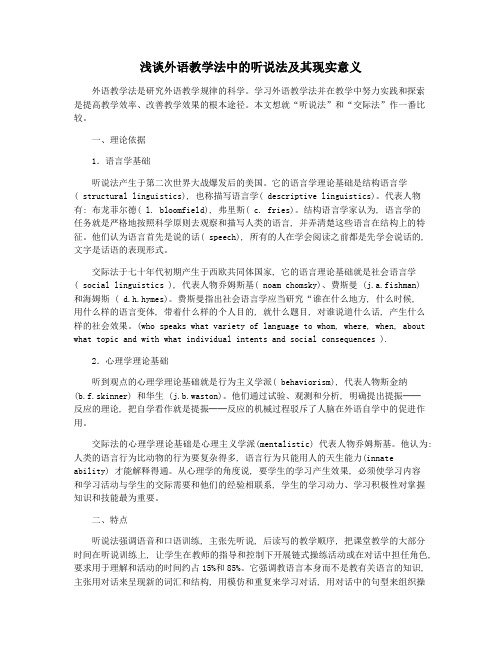
浅谈外语教学法中的听说法及其现实意义外语教学法是研究外语教学规律的科学。
学习外语教学法并在教学中努力实践和探索是提高教学效率、改善教学效果的根本途径。
本文想就“听说法”和“交际法”作一番比较。
一、理论依据1.语言学基础听说法产生于第二次世界大战爆发后的美国。
它的语言学理论基础是结构语言学( structural linguistics), 也称描写语言学( descriptive linguistics)。
代表人物有: 布龙菲尔德( l. bloomfield), 弗里斯( c. fries)。
结构语言学家认为, 语言学的任务就是严格地按照科学原则去观察和描写人类的语言, 并弄清楚这些语言在结构上的特征。
他们认为语言首先是说的话( speech), 所有的人在学会阅读之前都是先学会说话的, 文字是话语的表现形式。
交际法于七十年代初期产生于西欧共同体国家, 它的语言理论基础就是社会语言学( social linguistics ), 代表人物乔姆斯基( noam chomsky)、费斯曼 (j.a.fishman)和海姆斯 ( d.h.hymes)。
费斯曼指出社会语言学应当研究“谁在什么地方, 什么时候,用什么样的语言变体, 带着什么样的个人目的, 就什么题目, 对谁说道什么话, 产生什么样的社会效果。
(who speaks what variety of language to whom, where, when, about what topic and with what individual intents and social consequences ).2.心理学理论基础听到观点的心理学理论基础就是行为主义学派( behaviorism), 代表人物斯金纳(b.f.skinner) 和华生 (j.b.waston)。
他们通过试验、观测和分析, 明确提出提振──反应的理论, 把自学看作就是提振──反应的机械过程驳斥了人脑在外语自学中的促进作用。
听说教学法
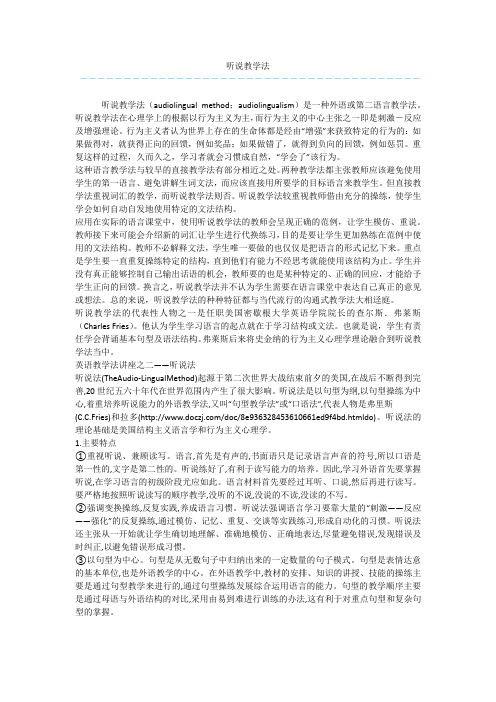
听说教学法---------------------------------------听说教学法(audiolingual method;audiolingualism)是一种外语或第二语言教学法。
听说教学法在心理学上的根据以行为主义为主,而行为主义的中心主张之一即是刺激-反应及增强理论。
行为主义者认为世界上存在的生命体都是经由“增强”来获致特定的行为的:如果做得对,就获得正向的回馈,例如奖品;如果做错了,就得到负向的回馈,例如惩罚。
重复这样的过程,久而久之,学习者就会习惯成自然,“学会了”该行为。
这种语言教学法与较早的直接教学法有部分相近之处。
两种教学法都主张教师应该避免使用学生的第一语言、避免讲解生词文法,而应该直接用所要学的目标语言来教学生。
但直接教学法重视词汇的教学,而听说教学法则否。
听说教学法较重视教师借由充分的操练,使学生学会如何自动自发地使用特定的文法结构。
应用在实际的语言课堂中,使用听说教学法的教师会呈现正确的范例,让学生模仿、重说。
教师接下来可能会介绍新的词汇让学生进行代换练习,目的是要让学生更加熟练在范例中使用的文法结构。
教师不必解释文法,学生唯一要做的也仅仅是把语言的形式记忆下来。
重点是学生要一直重复操练特定的结构,直到他们有能力不经思考就能使用该结构为止。
学生并没有真正能够控制自己输出话语的机会,教师要的也是某种特定的、正确的回应,才能给予学生正向的回馈。
换言之,听说教学法并不认为学生需要在语言课堂中表达自己真正的意见或想法。
总的来说,听说教学法的种种特征都与当代流行的沟通式教学法大相迳庭。
听说教学法的代表性人物之一是任职美国密歇根大学英语学院院长的查尔斯.弗莱斯(Charles Fries)。
他认为学生学习语言的起点就在于学习结构或文法。
也就是说,学生有责任学会背诵基本句型及语法结构。
弗莱斯后来将史金纳的行为主义心理学理论融合到听说教学法当中。
英语教学法讲座之二——听说法听说法(TheAudio-LingualMethod)起源于第二次世界大战结束前夕的美国,在战后不断得到完善,20世纪五六十年代在世界范围内产生了很大影响。
英语教学之听说法
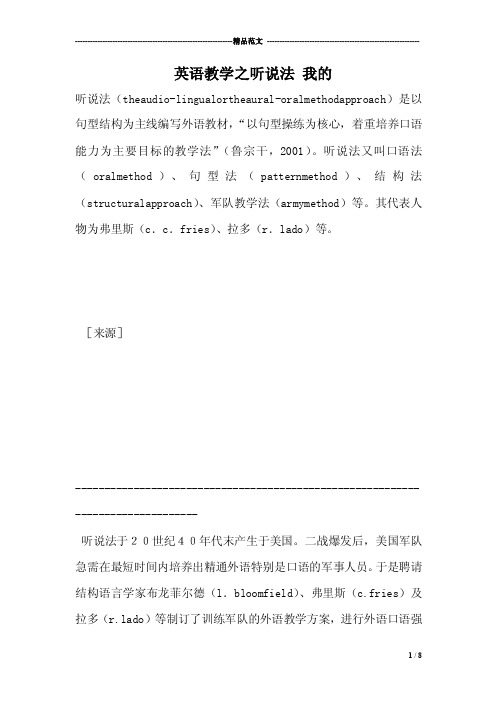
英语教学之听说法我的听说法(theaudio-lingualortheaural-oralmethodapproach)是以句型结构为主线编写外语教材,“以句型操练为核心,着重培养口语能力为主要目标的教学法”(鲁宗干,2001)。
听说法又叫口语法(oralmethod)、句型法(patternmethod)、结构法(structuralapproach)、军队教学法(armymethod)等。
其代表人物为弗里斯(c.c.fries)、拉多(r.lado)等。
[来源]--------------------------------------------------------------------------------听说法于20世纪40年代末产生于美国。
二战爆发后,美国军队急需在最短时间内培养出精通外语特别是口语的军事人员。
于是聘请结构语言学家布龙菲尔德(l.bloomfield)、弗里斯(c.fries)及拉多(do)等制订了训练军队的外语教学方案,进行外语口语强化训练。
这样便产生了听说法。
听说法主要盛行于二十世纪四十年代到六十年代,实际上是在直接法,特别在palmer的口语教学法体系基础上,与美国结构主义语言学观点相结合而形成的。
由于这种方法要求的是听和说,训练的方法也是听和说,听说法便因此而得名。
战后,许多语言学家和外语教学法家都很重视这个成就,并推广到普通学校的外语教学中去。
六十年代中叶,听说法的发展达到了顶峰,流传到世界各国,蜚声世界外语教学界。
[教学流程]--------------------------------------------------------------------------------心理学基础:听说法以行为心理学的基本原则为基础,并且吸纳了直接法的许多针对阅读法的口语技能不足的教学原则与教学程序(mora,2002)。
行为主义实际上渊源于巴甫洛夫学说。
听说法在英语教学中的应用

"听说法"(Audiolingual Method)是一种语言教学方法,旨在通过反复听和模仿,培养学生的语言听力和口语表达能力。
这一方法在英语教学中有一段时间内得到了广泛的应用。
以下是听说法在英语教学中的一些应用和特点:
1. 强调口语和听力:听说法主要强调口语和听力的训练。
学生通过模仿教师的语音、语调,反复练习口语表达,以培养流利的口语和敏锐的听力。
2. 结合日常情景:教学内容通常围绕日常生活情景展开,使学生在语言学习中更容易理解和应用。
通过模拟真实交际场景,鼓励学生运用所学语言进行实际交流。
3. 基于对话和模仿:课堂上通常会出现对话模型,学生需要听懂并模仿其中的语言表达。
这有助于培养学生的语感和语言表达能力。
4. 重视语音规律:听说法注重语音规律的教学,包括语音连读、音节强调等。
通过反复训练,学生能更好地掌握英语的语音特点。
5. 强调记忆和机械化学习:听说法在一定程度上强调学生的记忆和机械化学习。
学生通过不断的重复、模仿和记忆,达到能够熟练运用语言的目的。
6. 小组活动和合作学习:听说法通常包括小组活动和合作学习,通过与同学互动,学生可以更好地运用所学语言,提高交际能力。
7. 使用语言实例:教学过程中经常使用大量的语言实例,以便学生更好地理解和应用新的语言结构和表达方式。
需要注意的是,尽管听说法在过去曾经是主流的语言教学方法之一,但现代语言教学理论和实践更强调综合语言能力的培养,包括阅读、写作、听力和口语等。
因此,目前的语言教学往往采用多元化的方法,更注重培养学生的全面语言能力。
英语教学法之AudiolingualMethod(听说法)

英语教学法之AudiolingualMethod(听说法)Definition of Audio-lingual Method (American)a method of foreign or second Language teaching which emphasizes the teaching of speaking and listening before reading and writing; mother tongue is discouraged in the classroom.Historical and social backgroundI Prompted by WWIIThe Audio-lingual Method is in origin mainly American. The Audio-lingual Method was developed in the U.S. during the Second World War. At that time, the U.S. government found it a great necessity to set up a special language training program to supply the war with language personnel who could speak fluently in German, French, Italian, Chinese and other languages. The objectives of the army program were for students to attain conversational proficiency in a variety of foreign languages.The "methodology" of the Army Method was derived form the intensity of contact with L2 rather than from any well-developed methodological basis.The A udiolingua l Method is also known as the “informant method”, since it used a native speaker of the language, the informant, and a linguist.The informant served as a source of language for imitation, and the linguist supervised the learning experience.II Academic PromotionIn 1941 the first English Language Institute in the U.S. was established in the University of Michigan. The director of the institute was Charles Fries, who applied the principles of structural linguistics to LT. The result is an approach whichadvocated aural training first, then pronunciation training, followed by speaking, reading and writing.The emergence of the Audio-lingual Method resulted from the increased attention to FLT in the U.S. towards the end of the 1950s.III Political PromotionThe need for a radical change and rethinking of FLTM was promoted by the launching of the 1st Russian satellite i n 1957.The US government acknowledged the need for a more intensive effort to teach a foreign language in order to prevent American from becoming isolated from scientific advances made in other countries.IV the OutcomeThis need made LT specialists set about developing a method that was applicable to conditions in U.S. college and university classrooms. They draw on the earlier experiences of the army programmes and the Aural-Oral or Structural Approach developed by Fries and his colleagues, adding insights taken from behaviourist psychology.Structural linguistics views language as a system of structurally related elements (such as phonemes, morphemes, words, structure, and sentence types) for the expression of meaning.The grammatical system consists of a list of grammatical elements and rules for their linear combination into words, phrases and sentences.According to a structural view, language has the following characteristics in the Audiolingual Method:(1)Elements in a language are produced in a rule-governed (structured ) way.(2)Language samples could be exhaustively described at any structural level ofdescription.(3)Language is structured like a pyramid, that is, linguistic levels are system withinsystems.The structural linguists believed that the primary medium of language is oral. Thisview of language offered the foundations for the Audio-lingual Method in language teaching in which speech was given in a priority.The Audio-lingual Method is the first theories to recommend the development ofa language teaching theory on declared linguistic and psychological principles. TheoryTheory of learningLike structural linguistics, behaviorism is also anti-mentalistic, that is, it does not believe that a human being possesses a mind which has consciousness, ideas, etc, and that the mind can influence the behavior of the body.Behaviorism tires to explain how an external event (a stimulus) caused a change in the behavior of an individual (a response) without using concepts like “mind” or “ideas” or any kind of mental behavior.Behaviorist psychology states that human and animal behavior can and should be studied in terms of physical processes only.To the behaviorists, the human being is an organism capable of a wide repertoire of behaviors.occurrence of these behaviors is dependent upon threecrucial elements in learning:①stimulus②response③reinforcementAccording to the Audio-lingual Method, learning consists of stimulus-response connections.According to the Audio-lingual Method, learning is described as the formation of association between responses.To apply this theory to language learning is to identify the organism as the FL learner, the behavior as verbal behavior, the stimulus as what is taught (language input), the response as the learner’s reaction to the stimulus, and the reinforcement as the approval or praise (or discouragement) of the teacher or students.According to this behaviorist psychology, learning a language is a process of acquiring a set of appropriate language stimulus-response chains, a mechanical process of habit formation.This theory of learning is particularly associated with the American psychologist B.F. Skinner-----a famous Harvard behaviorist who believes that verbal behavior is the same as any other fundamental respect of non-verbal behavior.According to the behaviorist, a habit is formed when a correct response to a stimulus is consistently rewarded.The habit therefore is the result of stimulus, correct response and reward occurring again and again.According to Skinner, reward was much more effective than punishment in a teaching situation.In an audiolingual classroom, teachers are encouraged to show approval for each and every correct performance by their students, and every drill is designed so that the possibility ofmaking mistakes is minimized, engineering success for the students.Basic theoretical principles ( theory of language)The five slogans (Moulton, 1961) which express the basic theoretical principles of the Audiolingual Method. They reflect the influence of structural linguistics and behaviorist psychology in language teaching:①language is speech, not writing;②a language is what its native speakers say, not what someone thinks they ought to say;③languages are different;④a language is a set of habits;⑤teach the language, not about the language is a principle of the Audio-lingualMethod.This five principles became the tenets of language teaching doctrine during the post-war decades.RolesLearner rolesLessons in the classroom focus on the correct imitation of the teacher by the learners. Not only are the learners expected to produce the correct output, but attention is also paid to correct pronunciation. Although correct grammar is expected in usage, no explicit grammatical instruction is given. Furthermore, the target language is the only language to be used in the classroom.Teacher rolesThe Audio-lingual Method is a teacher- dominated model where the teacher role ismost crucial in the instruction of the language.According to the linguist Brooks “a teacher ” must betrained to introduce, sustain and harmonize the learning of the four skills in this order : learning, speaking, reading , writing “ and in the Audio-lingual Method , the teacher “controls the direction and pace and monitors and corrects the learners performance ”Instructional materialActive verbal interactions between teachers and learners and use of materials such as tape recorders and audiovisuals equipments to assist the teacher in the classroom play a central role in teaching a second language.In Audio-lingual Method the target language should be the medium of instruction and/or use and translations o f the native language should be discouraged.CommentsMeritsCombining language and images togethe r and putting them into language teaching, which cultivates the learner’s ability of thinking in target languageSetting ou t to meet the learner’s direct communicative competenc eFostering the learner’s ability of using language flexibly according to speci fic context situationHelping the learner to grasp target language naturally and firmlyDefects:Over emphasizing the principle of entire structureCutting the connection between the spoken and written form of the language apart artificiallyPaying too much attention to the role of audio-lingual aspect, without appropriate use of the mother tongueOverstressing language form s instead of actual communicative content (pseudofunctional)。
英语教学方法有哪几种

英语教学方法有哪几种英语教学方法是指教师在英语教学中运用的不同策略和技巧,旨在提高学生的语言水平和交际能力。
随着教育理论和科技的不断发展,目前存在着多种不同的英语教学方法。
以下将介绍其中几种常见的英语教学方法。
1. 交际法交际法是一种强调语言交际能力的教学方法。
它着重于提高学生的语言运用能力,通过真实的社交情境和实际的交际活动,培养学生的听、说、读、写的综合能力。
交际法注重学生的积极参与和语言输出,鼓励学生进行实际的语言交流,提高他们的交际效果。
2. 听说法听说法是一种注重听力和口语训练的教学方法。
它通过大量的听力材料和口语练习,帮助学生提高听力理解和口语表达能力。
听说法着重培养学生的语音、语调、语速,以及口语交际能力。
课堂上通常会进行各种听力练习和口语表达活动,例如听录音、角色扮演和小组对话等。
3. 语法翻译法语法翻译法是一种将英语语法和翻译技巧结合起来的教学方法。
它注重教授英语的语法规则和词汇,并通过翻译练习来巩固学生对语言知识的理解和运用。
语法翻译法相对传统,更加注重对语言结构和用法的准确理解,以及对词汇的掌握。
4. 任务型教学法任务型教学法是一种以任务为中心的教学方法。
它通过给学生提供真实的语言任务,培养学生的语言学习策略和解决问题的能力。
任务型教学法注重学生的主动参与和合作学习,激发学生的学习动机和兴趣。
5. 情景教学法情景教学法是一种通过情境和场景还原来进行教学的方法。
它通过创造真实的情境,帮助学生理解和运用语言。
情景教学法强调语言在特定情景中的运用,学生通过模拟真实情景进行语言表达,提高他们的语言运用能力。
综上所述,英语教学方法多种多样,每种方法都有其独特的优势和适用场景。
教师可以根据学生的需求和自身的教学风格选择最合适的方法,以提高学生的英语水平和学习效果。
在实际教学中,也可以结合多种方法,灵活运用,以达到最佳的教学效果。
听说教学法

听说教学法听说法(Audiolingual Method )又叫结构法或句型法,是美国流行的一种外语教学法。
《英语900句》是听说法的典型教材。
听说法产生的背景:二战之前美国的外语教学比较落后一方面,美国政治上的孤立主义使人们不关心国外的事物,这里面就包括外语,另一方面,英语在世界上流行很广,美国人到外国去,感觉不到学习外语的迫切需要。
二战爆发后,美国参战,派士兵参战。
但士兵不懂所去国家的语言,所以临时调外语教学法和语言学专家以及有经验的外语教师,成立外语训练中心,研究外语速成教学方法,编写专用的课本以6—8个月为一期,培训士兵。
要求士兵短期内能说日常生活上简单的外语,对他们的要求是听和说训练的方法也是听和说,听说法就这样产生了。
听说法的特征听说法的特征是认为语言是言语,不是文字,是习惯形成的。
重视模仿、记忆。
听说法的主要特点是主张以句型为纲来组织教学内容。
强调模仿、强记固定短语并大量重复,极其重视语音的正确,尤其强调语调训练,广泛利用对比法、在对比分析母语与外语的基础上学习外语的难点,并在教学中有针对性地加以解决。
二、听说教学法的主要特点听说教学法其理论基础是建立在现在语言学和心理学基础之上的,它是力求实现把教学材料即,教学活动和教学技巧融为一体的教学模式。
它的主要特点为:1、听说教学法比较重视口语能力的提高,可以帮助学习者去实现语言的准确性和流畅性。
视听法认为英语学习的最终目的就是学以致用,而这种应用就是让学生开口说。
语言的准确性在于对它做一个正确全面的理解,学习英语不仅仅只是对英语语法和结构的理解,而是在于对它进行超越字面意思的交流,从而完成对英语这种语言的整体理解。
2、听说法侧重于语言和情景密切集合。
传统英语教学往往把学生放在比较枯燥的语言环境中去学习,学生往往感受不到一个真实的语言环境,这对学习英语是不利的。
视听法除了注重学生的听说能力,往往是把学生放在一个真的语言环境里面,通过现代教学辅助手段,让学生一面看画面,一边练习听说,身临其境的学习英语,把看到的情景和听到的声音自然地联系起来,使学生的印象更加深刻。
英语教学法听说法例子

英语教学法听说法例子1. Role play: Divide the students into pairs or small groups and provide them with a scenario. For example, have them pretend to be in a restaurant and take turns ordering food and having a conversation with the waiter or waitress.2. Conversation circles: Have students sit in a circle and give thema topic to discuss. Each student takes turns speaking, practicing their speaking and listening skills. For example, the topic could be "What are your hobbies?" or "Describe your dream vacation."3. Think-pair-share: Have students think about a question or prompt, and then pair up with a partner to discuss their thoughts. After the discussion, each pair shares their ideas with the whole class. This encourages students to actively listen and participate in speaking activities.4. Debate: Divide the class into two groups and assign them a topic to debate. Each group takes turns presenting arguments for or against the topic. This activity encourages students to use persuasive language and develop their speaking skills.5. Show and tell: Have students bring in an object or picture that is meaningful to them and give a short presentation about it to the class. This activity allows students to practice speaking in front of others and share their personal experiences and stories.6. Interviews: Have students pair up and take turns interviewing each other. They can ask questions about personal interests, family, hobbies, or anything else. This activity helps students practiceasking and answering questions in a conversational setting.7. Picture description: Show students a picture and have them describe what they see in detail. This activity helps students practice speaking and using descriptive language.8. News discussion: Choose a current news article or video and have students discuss it in groups. They can share their opinions, ask questions, and debate different perspectives. This activity helps students practice speaking about real-world topics and improve their listening skills.9. Storytelling: Give students a writing prompt or picture, and have them create a story based on it. They can then take turns sharing their stories with the class. This activity helps students practice speaking fluently and creatively.10. Problem-solving: Present a problem or scenario to the class, and have students brainstorm solutions or discuss different approaches. This activity encourages students to think critically, express their ideas, and work collaboratively.。
中学英语常见的教学方法之听说法

中学英语常见的教学方法之听说法赣县吉埠中学龙建国听说法(audio-lingual method(一)听说法及其理论基础1.定义:听说法(audio-lingual method),又称“口语法”、“句型法”、“结构法”、“军队教学法”。
这是一种强调通过反复句型结构操练培养口语听说能力的教学法。
2.产生时间、背景:听说法于20世纪40年代在美国产生。
第二次世界大战爆发后,美国军队为在短期内培养大批掌握外语口语能力的军人,采取一系列的措施和手段强化训练士兵的听说能力,听说法便应运而生。
战后,该法被推广应用到学校外语教学中,并在20世纪五六十年代风行美国和西方各国。
3. 理论基础:①语言学理论基础是美国结构主义语言学,该法强调第二语言教学要从口语开始,从说话开始,通过掌握语言结构学会目的语。
②心理学基础是行为主义心理学的刺激---反应论。
认为言语行为是通过刺激与反应的联结并加以强化而形成习惯,强调第二语言教学要通过大量的模仿和反复操练养成新的语言习惯。
4.教学过程:美国布朗大学特瓦德尔教授在1958年把听说法的教学过程归纳为认知、模仿、重复、变换、选择五个阶段。
(二)听说法的主要特征听说法的主要特征表现在以下7个方面。
(1)听说领先。
注重口语,听说领先,听说是一切言语活动的基础。
口语是第一位的,读写是在听说的基础上派生出来的;初级阶段先练口语,以培养口语能力为主,读写为辅。
(2)反复操练,用模仿、重复、记忆的方法去反复实践,形成自动化的习惯。
(3)以句型为中心。
句型是语言教学的基础,也是外语教学的中心,通过句型操练能自动化地运用每一个句型,掌握目的语。
(4)排斥或限制使用母语和翻译,尽量用直观手段或借助于情景、语境,直接用目的语理解和表达。
(5)对比语言结构,确定教学难点,把外语教学的主要力量放在攻克难点上。
语言结构对比包括母语同目的语结构的对比分析和目的语结构内部的对比分析。
(6)能及时、严格地纠正学习者出现的错误,培养正确的语言习惯。
英语教学法之Audiolingual-Method(听说法)
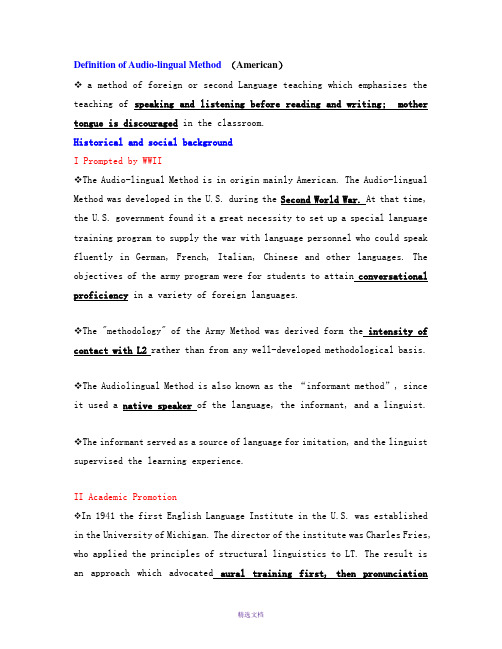
I Prompted by WWII
The Audio-lingual Method is in origin mainly American. The Audio-lingual Method was developed in theU.S.during theSecond World War.At that time, ernment found it a great necessity to set up a special language training programto supply the war with language personnel who could speak fluently in German, French, Italian, Chinese and other languages. Theobjectives of the army programwere for students to attainconversational proficiencyin a variety of foreign languages.
Definition of Audio-lingual Method(American)
a method of foreign or second Language teaching which emphasizes the teaching ofspeaking and listening before reading and writing;mother tongue is discouragedin the classroom.
The informant served as a source of language for imitation, and the linguist supervised the learning experience.
【全文】英语教学法之听说法
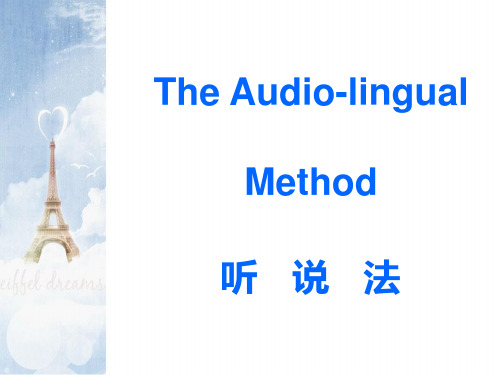
• Individual differences in students received fresh consideration.
• It is among the first theories to recommend the development of a language teaching theory on declared linguistic and psychological principles.
• Discouraging the use of the mother tongue in the classroom,
• Use of language laboratory.
Objectives
• To enable students to use the target language communicatively.
• In 1914 the first English Language Institute in the U.S. was established in the University of Michigan.
Theoretical Basis
• Theory of language:
1. Elements in a language are produቤተ መጻሕፍቲ ባይዱed in a rule-governed (structured) way.
1. Language is speech, not writing. 2. A language is what its native
speakers say, not what someone thinks they ought to say. 3. Languages are different. 4. A language is a set of habits. 5. Teach the language, not about the language.
英语教学法听说法

听说法是一种英语教学法,也被称为句型教学法,产生于20世纪40年代的美国。
其特点包括:
新课内容以会话形式展开。
学习者通过模仿、记忆、重复等方式学习,以养成语言习惯。
语言结构按序排列,依次教学。
句型结构反复操练,语法教学用归纳法进行类推,很少进行语法解释。
严格控制语汇量,词汇依赖上下文来学习。
重视语音教学。
大量使用视听设备和语言实验室。
对学生成功的反应立即予以强化,尽量防止学生出现错误。
按听、说、读、写的顺序安排教学。
听说法以行为主义心理学为理论基础,主张通过刺激-反应及增强理论来教授语言。
其核心观点是如果学习者对某个语言行为得到强化(如奖赏),他就会更倾向于在类似情境中再次执行这个行为;反之,如果他的某个语言行为没有得到强化或者被惩罚了(如批评或惩罚),他就会倾向于避免在类似情境中再次执行这个行为。
听说法认为语言是一种习惯,因此它强调学习者应该反复地模仿和操练特定的语言形式,直到这些形式成为他们的习惯为止。
在模仿
和操练的过程中,学习者需要不断地重复语言形式,直到他们能够自然地、无意识地使用这些形式。
总的来说,听说法强调通过模仿和操练来培养学习者的语言习惯,并主张在语言课堂中采用视听设备和语言实验室等现代化教学工具,以提高教学效果。
浅谈中等职业学校英语教学——听说法

浅谈中等职业学校英语教学——听说法我们要结合职业中专的学生实际和其专业的特点,通过把英语作为一个交流工具学习,运用听说法教学努力提高学生的英语口语。
听说法是以结构主义语言学研究外语教学问题的。
听说法把听说放在首位,主张先用耳听,后用口说,经过反复口头操练,最终能自动化地运用所学语言材料,即把听到的英语能用口头表达出来。
美国普林斯顿大学教授莫尔登把听说法理论基础概括为下列五点:1、语言是说的话,而不是写出来的文字。
2、语言是一套习惯。
3、教语言,而不是教有关语言的知识。
4、语言是本族人所说的话,而不是某个人认为他们应该如何说的话。
5、语言是不同的。
听说法的理论基础是美国结构主义语言学和行为主义心理学。
语言学家通过调查研究发现,操一种语言的人口头讲的话与该种语言的传统语法有些地方是不一致的。
在他们看来口语是活的语言,学习语言主要是学习口语。
心理学家根据观察、分析动物和人的心理结果,认为人和动物的行为有一个共同的因素:刺激和反应。
在进一步的研究基础上,得出语言教学即是教师对学生进行声音刺激和学生对声音刺激进行反应过程的理论。
在教学中听说法分五步完成,即认知、模仿、重复、变换和选择:1、教师发出语言信号(主要是句型),同时借助实物、图片、手势、情景等说明信号所表达的意思。
2、当学生理解了新的语言材料后,教师批复示范,学生跟着模仿,教师要纠正学生的错误,学生再模仿。
3、让学生不断重复所学的语言材料,直到能背诵为止。
4、作变换句子结构练习。
5、选择某些词汇、成语和句型,用来描述特定的场面、情景或某一事件,以培养学生运用学过的语言材料进行交际实践的能力。
采用听说法教学的几项基本原则:1、听说领先。
以听说为主,读写为辅。
在学生打下一定的听说基础以后,再进行读写教学,使读写促进听说。
2、反复实践,形成习惯。
在教学中要让学生把大部分时间用在模仿、记忆、重复、交谈等实践练习上,在大量操练的基础上养成一套新的语言习惯。
3、现代外语教学法--听说法

听说法(Audio-lingual Approach)又称口语法(Oral Approach)等。
听说法产生于第二次世界大战时期的美国。
为了满足战时的需要,有成千上万的士兵、军官在几十所高等学校采用听说法集中训练学习,分别接受几十种外语强化训练。
听说法的创始人是语言学家、外语教学法专家弗里斯。
他创办英语研究所,专门研究把英语作为外语的教学问题,不仅编写了大量教材和教学参考资料,而且进行了大量的教学实践,为一些地区培养了大批掌握英语的人才。
二十世纪六十年代是听说法发展的全盛时期,几乎成了外语教学界。
占支配地位的一种外语教学法,听说法在七十年代是我国中学、大学外语教学的主要教学方法。
听说法的理论基础主要是美国结构主义语言学和行为主要心理学。
他们认为:语言是有声的,口语是第一性的,每种语言的特点集中表现在句子结构上,语言是习惯的综合体系,学习语言就是养成一种习惯,语言习得的过程是刺激—反应—强化的过程,新语言习惯的形成要靠反复、大量的机械操练。
1、听说法的特点1)以句型为中心。
句型是外语教学的基础,外语教学以句型结构操练为中心,其教学顺序主要是通过母语与外语结构的对比,采用由易到难的办法。
2)听说领先。
口语是第一性的,文字是第二性的。
口语是外语的基础,采用先听说,后读写的原则。
3)外语教学要尽量减少或限制母语的干扰作用。
4)外语教学的目的是养成听说读写的能力,特别是听说能力。
培养听说能力主要依靠刺激—反应—强化的反复训练,形成自动化的习惯。
2、听说法的优点1)重视听说能力的培养。
2)重视句型教学,通过句型操练进行听说读写基本训练,形成自动化言语习惯,掌握外语语感。
3)对比分析母语与外语的结构特点,确定教学的难点,并在教学中有针对性地加以解决。
3、听说法的缺点1)过分重视机械系的句型操练,忽视掌握语言基础知识和活用语言能力的培养,因而不利于学生实践掌握外语。
同时机械性操练容易引起学生枯燥乏味的感觉,造成外语课堂气氛的沉闷。
听说法

听说法
听说法:把 “听说放在首位,主张先用耳听,后用 口说,经过反复口头操练,最终能自动化地运用所 学语言材料” 的一种外语、李琪、李丽蓉
• • • • •
一、历史背景及代表人物 二、理论基础 三、基本原则 四、教学过程 五、评价
历史背景及
历史背景:
20世纪40年代美国成为世界大国,同各国交往频繁急需大量的外语人才应对外 交、外贸、科技等领域的各种活动。在这之前美国外语教育主要是沿袭语法翻译 法,注重阅读并不注重口头表达,无法短时间内培养出适应社会发展的外语人才。
因此改革外语教学的呼声很高,于是当时的语言学家和语言教室提出将二战时 期的外语教学方法运用到学校中,由此形成听说法。
二战期间,珍珠港事件发生后,军队设立专门的教学机构进行培训,当时的教学 方法的又两大特点,集中速成教学和采用听说法进行训练。
主要代表人物
• 1.弗里斯 美国人,语言学家及外语教学法家。 提倡口语法 著作:《作为外语的英语教学》、《英语句型操练》、《美 国英语教科书》 • 2.拉多 美国人,结构主义语言学家 著作:《语言教学和科学方法》 这部著名的理论著作从理论和实践两方面把口语法向前推进 了一大步。
听说法

听说法(Audio-lingual Approach)(一)听说法及其理论基础1.定义:听说法(audiolingual method),又称“口语法”、“句型法”、“结构法”、“军队教学法”、“耳口法”。
这是一种强调通过反复句型结构操练培养口语听说能力的教学法。
2.产生时间和背景听说法于20世纪40年代在美国产生。
第二次世界大战爆发后,美国军队为在短期内培养大批掌握外语口语能力的军人,采取一系列的措施和手段强化训练士兵的听说能力,听说法便应运而生。
战后,该法被推广应用到学校外语教学中,并在20世纪五六十年代风行美国和西方各国。
3. 理论基础①语言学理论基础是美国结构主义语言学,该法强调第二语言教学要从口语开始,从说话开始,通过掌握语言结构学会目的语。
②心理学基础是行为主义心理学的刺激---反应论。
认为言语行为是通过刺激与反应的联结并加以强化而形成习惯,强调第二语言教学要通过大量的模仿和反复操练养成新的语言习惯。
4.教学过程美国布朗大学特瓦德尔教授在1958年把听说法的教学过程归纳为认知,模仿,重复,变换,选择五个阶段。
5.听说法的主要代表人物弗里斯(C.C Fries)拉多(do)(二)听说法的主要特征听说放在首位,先用耳听,后用口说(audio-oral,反复口头操练,最终能自动化地运用所学语言材料。
(1)听说领先。
注重口语,听说领先,听说是一切言语活动的基础。
口语是第一位的,读写是在听说的基础上派生出来的;初级阶段先练口语,以培养口语能力为主,读写为辅。
(2)反复操练,用模仿,重复,记忆的方法去反复实践,形成自动化的习惯。
(3)以句型为中心。
句型是语言教学的基础,也是外语教学的中心,通过句型操练能自动化地运用每一个句型,掌握目的语。
(4)排斥或限制使用母语和翻译,尽量用直观手段或借助于情景,语境,直接用目的语理解和表达。
(5)对比语言结构,确定教学难点,把外语教学的主要力量放在攻克难点上。
听说法
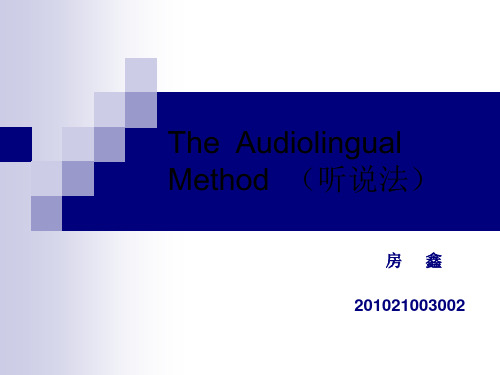
Background
British
applied linguists during the same period a. Little attempt to treat language content systematically. b. no standardization of the vocabulary or grammar that was included
Charles Fries
He applied the principles of structural linguistics to language teaching. Grammar was the starting point. The structure of the language was identified with its basic sentence patterns and grammatical structures. The language was taught by systematic attention to pronunciation and by intensive oral drills. Pattern practice was a basic classroom technique.
Back-ground
1.1950年代末期外语教学在美国日益受重 视的结果. 2. 1957年苏联发射人造卫星 3. 1964年首次使用此名词,视al Method
The
army program+ the Aural-Oral Approach +behaviorist psychology Structural linguistic theory + contrastive analysis + aural-oral procedures+ structural linguistic theory
- 1、下载文档前请自行甄别文档内容的完整性,平台不提供额外的编辑、内容补充、找答案等附加服务。
- 2、"仅部分预览"的文档,不可在线预览部分如存在完整性等问题,可反馈申请退款(可完整预览的文档不适用该条件!)。
- 3、如文档侵犯您的权益,请联系客服反馈,我们会尽快为您处理(人工客服工作时间:9:00-18:30)。
• Emphasis on certain practice techniques: mimicry, memorization and pattern drills. • Discouraging the use of the mother tongue in the classroom, • Use of language laboratory.
• Theory of Learning:
1. Language is speech, not writing. 2. A language is what its native speakers say, not what someone thinks they ought to say. 3. Languages are different. 4. A language is a set of habits. 5. Teach the language, not about the language.
Objectives
• To enable students to use the target language communicatively. • To train in listening comprehension, accurate pronunciatiion, reading comprehension and production of correct sentences in writing.
6. Expansion drill 7. Clause combination drill 8. Backward build-up drill 9. Chain drill 10. Mini-dialogue drill
Summary and Comments
• Its theoretical basis was found to be weak. • Techniques used in the Audio-linqual Method are also found faulty. • The teacher's role is central and active. • Materials in this method are primarily teacher-oriented. • Individual differences in students received fresh consideration.
Exemplification
• • • • Recognition Imitation and Repetiton Patter Drills Follow-up Activities
Techniques
1. Repeti3. Progressive drill 4. Transformation drill 5. Question-and answer drill
Theoretical Basis
• Theory of language:
1. Elements in a language are produced in a rule-governed (structured) way. 2. Language samples could be exhaustively described at any structural level of description. 3. Language is structured like a pyramid.
• It is among the first theories to recommend the development of a language teaching theory on declared linguistic and psychological principles. • It attemps to make language learning accessible to large groups of ordinary learners. • It stresses syntactic progression and uses pattern drills to help the students gain control over grammatical structures.
The Audio-lingual Method 听 说 法
Background
• It was developed in the U.S. during WWII for military purposes. • Linguists and applied linguists during this period were becoming increasingly involved in the English study as a foreign language. • In 1914 the first English Language Institute in the U.S. was established in the University of Michigan.
• The development of mastery in all four language skills. • To develope in the students the same types of abilities that native speakers have, to use it automatically without stopping to think.
Basic Principles
• Seperation of language skills into listening, speaking, reading and writing, with emphasis on the teaching of listening and speaking. • Use of dialogues as the chief means of presenting the language.
